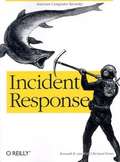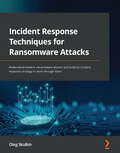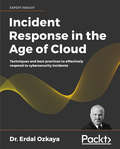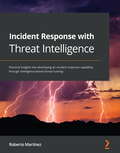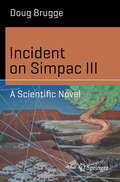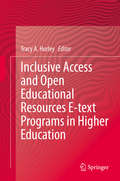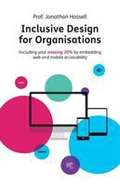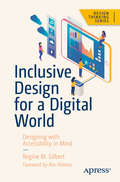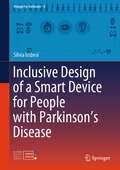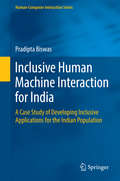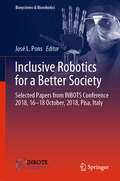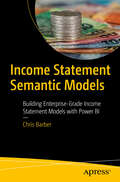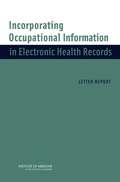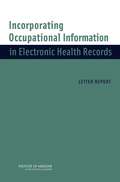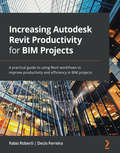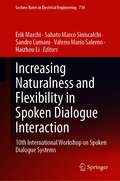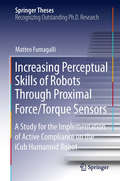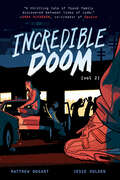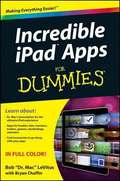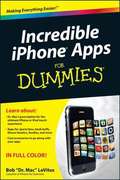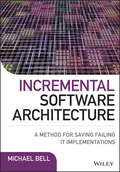- Table View
- List View
Incident Management for Operations
by Chris Hawley Rob Schnepp Ron VidalAre you satisfied with the way your company responds to IT incidents? How prepared is your response team to handle critical, time-sensitive events such as service disruptions and security breaches? IT professionals looking for effective response models have successfully adopted the Incident Management System (IMS) used by firefighters throughout the US. This practical book shows you how to apply the same response methodology to your own IT operation.You’ll learn how IMS best practices for leading people and managing time apply directly to IT incidents where the stakes are high and outcomes are uncertain. This book provides use cases of some of the largest (and smallest) IT operations teams in the world. There is a better way to respond. You just found it.Assess your IT incident response with the PROCESS programmatic evaluation toolGet an overview of the IMS all-hazard, all-risk frameworkUnderstand the responsibilities of the Incident CommanderForm a unified command structure for events that affect multiple business unitsSystematically evaluate what broke and how the incident team responded
Incident Response
by Richard Forno Kenneth R. van WykAre you ready for a computer "incident," such as a security breach? Incident Responseshows you both the technical and administrative aspects of building an effective incident response plan. You'll learn about the different types of incidents and ways to respond to them, how to put together an incident response team, what procedures to use, what tools there are for investigating incidents, and where to find extensive online resources.
Incident Response Techniques for Ransomware Attacks: Understand modern ransomware attacks and build an incident response strategy to work through them
by Oleg SkulkinExplore the world of modern human-operated ransomware attacks, along with covering steps to properly investigate them and collecting and analyzing cyber threat intelligence using cutting-edge methods and toolsKey FeaturesUnderstand modern human-operated cyber attacks, focusing on threat actor tactics, techniques, and proceduresCollect and analyze ransomware-related cyber threat intelligence from various sourcesUse forensic methods and tools to reconstruct ransomware attacks and prevent them in the early stagesBook DescriptionRansomware attacks have become the strongest and most persistent threat for many companies around the globe. Building an effective incident response plan to prevent a ransomware attack is crucial and may help you avoid heavy losses. Incident Response Techniques for Ransomware Attacks is designed to help you do just that.This book starts by discussing the history of ransomware, showing you how the threat landscape has changed over the years, while also covering the process of incident response in detail. You'll then learn how to collect and produce ransomware-related cyber threat intelligence and look at threat actor tactics, techniques, and procedures. Next, the book focuses on various forensic artifacts in order to reconstruct each stage of a human-operated ransomware attack life cycle. In the concluding chapters, you'll get to grips with various kill chains and discover a new one: the Unified Ransomware Kill Chain.By the end of this ransomware book, you'll be equipped with the skills you need to build an incident response strategy for all ransomware attacks.What you will learnUnderstand the modern ransomware threat landscapeExplore the incident response process in the context of ransomwareDiscover how to collect and produce ransomware-related cyber threat intelligenceUse forensic methods to collect relevant artifacts during incident responseInterpret collected data to understand threat actor tactics, techniques, and proceduresUnderstand how to reconstruct the ransomware attack kill chainWho this book is forThis book is for security researchers, security analysts, or anyone in the incident response landscape who is responsible for building an incident response model for ransomware attacks. A basic understanding of cyber threats will be helpful to get the most out of this book.
Incident Response in the Age of Cloud: Techniques and best practices to effectively respond to cybersecurity incidents
by Dr. Erdal OzkayaLearn to identify a security incident and build a series of best practices to stop a cyberattack before it creates serious consequencesKey FeaturesDiscover Incident Response (IR), from its evolution to implementationUnderstand cybersecurity essentials and IR best practices through real-world phishing incident scenariosExplore the current challenges in IR through the perspectives of leading figures in the cybersecurity communityBook DescriptionCybercriminals are always in search of new methods and ways to infiltrate systems. Quickly responding to an incident should help an organization minimize its losses, decrease vulnerabilities, and rebuild services and processes. In the wake of the COVID-19 pandemic, with most organizations gravitating towards remote working and cloud computing, this book provides updated IR processes to address the associated security risks. The book begins by introducing you to the cybersecurity landscape and explaining why IR matters. You will understand the evolution of IR, current challenges, key metrics, and the composition of an IR team, along with an array of methods and tools used in an effective IR process. You will then learn how to apply this conceptual toolkit, with discussions on incident alerting, handling, investigation, recovery, and reporting. Further, you will cover governing IR on multiple platforms and sharing cyber threat intelligence, and the procedures involved in IR in the cloud – the challenges, opportunities, and how to secure your cloud environments. Finally, the book concludes with an “Ask the Experts” section where industry experts have provided their perspective on diverse topics in the IR sphere. By the end of this book, you should become proficient at building and applying IR strategies pre-emptively and confidently. What you will learnUnderstand IR and its significanceOrganize an IR teamExplore best practices for managing attack situations with your IR teamForm, organize, and operate a product security team to deal with product vulnerabilities and assess their severityOrganize all the entities involved in product security responseRespond to a security vulnerability based on Keepnet Labs processes and practicesAdapt all the above learnings for the cloudWho this book is forThis book is aimed at first-time incident responders, cybersecurity enthusiasts who want to get into IR, and anyone who is responsible for maintaining business security. It will also interest CIOs, CISOs, and members of IR, SOC, and CSIRT teams. However, IR is not just about information technology (IT) or security teams, and anyone with a legal, HR, media, or other active business role would benefit from this book.The book assumes you have some admin experience. No prior DFIR experience is required. Some infosec knowledge will be a plus but isn't mandatory.
Incident Response with Threat Intelligence: Practical insights into developing an incident response capability through intelligence-based threat hunting
by Roberto MartinezLearn everything you need to know to respond to advanced cybersecurity incidents through threat hunting using threat intelligenceKey FeaturesUnderstand best practices for detecting, containing, and recovering from modern cyber threatsGet practical experience embracing incident response using intelligence-based threat hunting techniquesImplement and orchestrate different incident response, monitoring, intelligence, and investigation platformsBook DescriptionWith constantly evolving cyber threats, developing a cybersecurity incident response capability to identify and contain threats is indispensable for any organization regardless of its size. This book covers theoretical concepts and a variety of real-life scenarios that will help you to apply these concepts within your organization.Starting with the basics of incident response, the book introduces you to professional practices and advanced concepts for integrating threat hunting and threat intelligence procedures in the identification, contention, and eradication stages of the incident response cycle. As you progress through the chapters, you'll cover the different aspects of developing an incident response program. You'll learn the implementation and use of platforms such as TheHive and ELK and tools for evidence collection such as Velociraptor and KAPE before getting to grips with the integration of frameworks such as Cyber Kill Chain and MITRE ATT&CK for analysis and investigation. You'll also explore methodologies and tools for cyber threat hunting with Sigma and YARA rules.By the end of this book, you'll have learned everything you need to respond to cybersecurity incidents using threat intelligence.What you will learnExplore the fundamentals of incident response and incident managementFind out how to develop incident response capabilitiesUnderstand the development of incident response plans and playbooksAlign incident response procedures with business continuityIdentify incident response requirements and orchestrate people, processes, and technologiesDiscover methodologies and tools to integrate cyber threat intelligence and threat hunting into incident responseWho this book is forIf you are an information security professional or anyone who wants to learn the principles of incident management, first response, threat hunting, and threat intelligence using a variety of platforms and tools, this book is for you. Although not necessary, basic knowledge of Linux, Windows internals, and network protocols will be helpful.
Incident on Simpac III: A Scientific Novel (Science and Fiction)
by Doug BruggeA few hundred years into the future, a wave of space colonization follows a disastrous earlier attempt to inhabit nearby extrasolar planets. It is guided by a new computational method based on massive data-driven socio-cultural and socio-epidemiological modeling and using novel biological computers, fed with data on Earth’s history of successes and failures. Yet, in the newly settled Simpac system, some unexpected and worrying anomalies begin cropping up, making an urgent expedition to the system necessary: is it the underlying data, the computations, or is some unknown entity tampering with the space colonization program? A race against time ensues as the lives of four strangers begin to converge. While grounded in the social systems aspect, the author posits that the future is likely to be characterized by more biology-based tools than most contemporary science fiction – which most often relies entirely on non-biological hardware in terms of advanced technologies – predicts. The result is an entertaining and skillful blend of thriller and SF, complemented by a nontechnical appendix describing the underlying science.
Inclusive Access and Open Educational Resources E-text Programs in Higher Education
by Tracy A. HurleyThis volume takes a comprehensive and broad look at e-text programs across a wide spectrum of programs, institutions, and policies in three parts. The first part showcases several policy papers to contextualize the discussion and highlight the reasons for IAE programs’ structure and the obstacles they face for implementation. The second part is an in-depth exploration of various case studies that provide a detailed description of IAE programs, including information about program elements, program structure, program size, and insights into how programs are operationalized, and their shortcomings and benefits to students and stakeholders. The final part is a selection of research papers that offer evidence-based support for the adoption of IAE programs in terms of student success, access, engagement, costs, and a variety of other student and institutional outcomes. There are approximately 300 institutions of higher education that currently have some form of Inclusive Access or Open Educational Resources E-text (IAE) program in the United States, but there is little scholarship that engages on the topic of assessing these programs’ effect on student success. The results of the research studies included in this volume will inform faculty, administrators, and policy-makers who seek to support the development, adoption, and implementation of IAE programs based on their potential positive effects on student success and other outcomes.
Inclusive Design For Organisations: Including Your Missing 20% By Embedding Web And Mobile Accessibility
by Jonathan HassellMost organisations are oblivious to, or terrified about, web accessibility. <p><p> You may be aware that 20% of your customers - people with disabilities - could be clicking away from your websites or mobile apps every day, without having bought anything or found the information they needed. You may have received complaints about accessibility problems you don't understand, with people asking for what seem like impossible fixes. Your web teams may have read the industry standard WCAG guidelines, but found them impenetrable. You probably know you could be sued if you don't do the right thing, but you don't know how far you need to go to prevent that. And apart from eliminating risk, what else is in it for your organisation? <p> In this book, award-winning international accessibility thought-leader Jonathan Hassell shows you how to transform your organisation to consistently and cost-efficiently create websites, mobile apps and other digital products that are usable for all of your customers. <p> Inclusive Design for Organisations gives you a clear, strategic business-aligned framework how to embed accessibility policies and processes consistently throughout your organisation, and how to measure the return on your investment. <p> With insights from leading worldwide accessibility experts who have implemented these processes in their organisations, this book comes with a free library of downloadable support tools, templates, podcasts and videos to help you on your journey to accessibility maturity. <p> Inclusive Design for Organisations, and its companion, Inclusive Design for Products, will help you comply with both parts of the new International Standard ISO 30071-1.
Inclusive Design for a Digital World: Designing with Accessibility in Mind
by Regine M. GilbertWhat is inclusive design? It is simple. It means that your product has been created with the intention of being accessible to as many different users as possible. For a long time, the concept of accessibility has been limited in terms of only defining physical spaces. However, change is afoot: personal technology now plays a part in the everyday lives of most of us, and thus it is a responsibility for designers of apps, web pages, and more public-facing tech products to make them accessible to all. Our digital era brings progressive ideas and paradigm shifts – but they are only truly progressive if everybody can participate.In Inclusive Design for a Digital World, multiple crucial aspects of technological accessibility are confronted, followed by step-by-step solutions from User Experience Design professor and author Regine Gilbert. Think about every potential user who could be using your product. Could they be visually impaired? Have limited motor skills? Be deaf or hard of hearing? This book addresses a plethora of web accessibility issues that people with disabilities face. Your app might be blocking out an entire sector of the population without you ever intending or realizing it. For example, is your instructional text full of animated words and Emoji icons? This makes it difficult for a user with vision impairment to use an assistive reading device, such as a speech synthesizer, along with your app correctly. In Inclusive Design for a Digital World, Gilbert covers the Web Content Accessibility Guidelines (WCAG) 2.1 requirements, emerging technologies such as VR and AR, best practices for web development, and more.As a creator in the modern digital era, your aim should be to make products that are inclusive of all people. Technology has, overall, increased connection and information equality around the world. To continue its impact, access and usability of such technology must be made a priority, and there is no better place to get started than Inclusive Design for a Digital World.What You’ll LearnThe moral, ethical, and high level legal reasons for accessible designTools and best practices for user research and web developersThe different types of designs for disabilities on various platformsFamiliarize yourself with web compliance guidelinesTest products and usability best practicesUnderstand past innovations and future opportunities for continued improvementWho This Book Is ForPractitioners of product design, product development, content, and design can benefit from this book.
Inclusive Design of a Smart Device for People with Parkinson’s Disease (Design For Inclusion #4)
by Silvia ImbesiThis book reports on an inclusive design project aimed at developing IoT-based wearable devices for special populations. Specifically, it covers the design, the implementation and testing of a smart mHealth system that uses sensory cues to monitor and train the gait and posture of people with Parkinson’s disease. It presents a user-centred strategy to better involve the users in defining the most suitable type of sensory cues and their combination, and in the design of the user interface, at the purpose of developing a gait tutoring system that better fits users’ needs and requirements. All in all, this book offers extensive information on the state-of-the-art in the design and testing of innovative user-centred mHealth systems. Giving a particular attention to the explanation of the tools and methodological choices, it provides readers with a timely reference guide to understand and deal with complex inclusive design projects.
Inclusive Human Machine Interaction for India
by Pradipta BiswasRapid advancement of interactive technologies during the past two decades has made access to information easier though at the expense of a clear digital divide. There is a generation who grew up with these technologies and another generation who find many modern electronic systems counter intuitive and have no use for them in their daily life. This digital divide becomes more prominent in developing countries as state-of-the-art interactive systems were not and are still not affordable to a large number of users. Inclusive Human Machine Interaction for India presents an end-to-end case study of developing interactive technology for the common people of India. With a foreword from Prof Ashok Juhunjhunwala (Professor, Indian Institute of Technology Madras), this book investigates problems of middle-aged and elderly users in adopting interactive technologies and proposes new user interfaces and interaction techniques. It pioneers in introducing state-of-the-art eye-gaze tracking based interaction to everyday computing tasks and presents a detailed literature survey and user studies on user modelling and eye-gaze tracking. Technologies presented in this book will not only be relevant for developing countries but will also find useful applications in developed countries.
Inclusive Robotics for a Better Society: Selected Papers from INBOTS Conference 2018, 16-18 October, 2018, Pisa, Italy (Biosystems & Biorobotics #25)
by José L. PonsThe book reports on advanced topics in interactive robotics research and practice; in particular, it addresses non-technical obstacles to the broadest uptake of these technologies. It focuses on new technologies that can physically and cognitively interact with humans, including neural interfaces, soft wearable robots, and sensor and actuator technologies; further, it discusses important regulatory challenges, including but not limited to business models, standardization, education and ethical–legal–socioeconomic issues. Gathering the outcomes of the 1st INBOTS Conference (INBOTS2018), held on October 16–20, 2018 in Pisa, Italy, the book addresses the needs of a broad audience of academics and professionals working in government and industry, as well as end users. In addition to providing readers with detailed information and a source of inspiration for new projects and collaborations, it discusses representative case studies highlighting practical challenges in the implementation of interactive robots in a number of fields, as well as solutions to improve communication between different stakeholders. By merging engineering, medical, ethical and political perspectives, the book offers a multidisciplinary, timely snapshot of interactive robotics.
Income Statement Semantic Models: Building Enterprise-Grade Income Statement Models with Power BI
by Chris BarberThis comprehensive guide will teach you how to build an income statement semantic model, also known as the profit and loss (P&L) statement. Author Chris Barber— a business intelligence (BI) consultant, Microsoft MVP, and chartered accountant (ACMA, CGMA)—helps you master everything from designing conceptual models to building semantic models based on these designs. You will learn how to build a re-usable solution based on the trial balance and how to expand upon this to build enterprise-grade solutions. If you want to leverage the Microsoft BI platform to understand profit within your organization, this is the resource you need. What You Will Learn Modeling and the income statement: Learn what modelling the income statement entails, why it is important, and how income statements are constructed Calculating account balances: Learn how to optimally calculate account balances using a Star Schema Producing external income statement semantic models: Learn how to produce external income statement semantic models as they enable income statements to be analyzed from a range of perspectives and can be explored to reveal the underlying accounts and journal entries Producing internal income statement semantic models: Learn how to create multiple income statement layouts and further contextualize financial information by including percentages and non-financial information, and learn about the various security and self-service considerations Who This Book Is For Technical users (solution architects, Microsoft Fabric developers, Power BI developers) who require a comprehensive methodology for income statement semantic models because of the modeling complexities and knowledge needed of the accounting process; and finance (management accountants) who have hit the limits of Excel and have started using Power BI, but are unsure how income statement semantic models are built
Incorporating Occupational Information in Electronic Health Records: Letter Report
by Linda Hawes CleverEach year in the United States, more than 4,000 occupational fatalities and more than 3 million occupational injuries occur along with more than 160,000 cases of occupational illnesses. Incorporating patients' occupational information into electronic health records (EHRs) could lead to more informed clinical diagnosis and treatment plans as well as more effective policies, interventions, and prevention strategies to improve the overall health of the working population. At the request of the National Institute for Occupational Safety and Health, the IOM appointed a committee to examine the rationale and feasibility of incorporating occupational information in patients' EHRs. The IOM concluded that three data elements - occupation, industry, and work-relatedness - were ready for immediate focus, and made recommendations on moving forward efforts to incorporate these elements into EHRs.
Incorporating Occupational Information in Electronic Health Records: Letter Report
by The National Academy of SciencesEach year in the United States, more than 4,000 occupational fatalities and more than 3 million occupational injuries occur along with more than 160,000 cases of occupational illnesses. Incorporating patients' occupational information into electronic health records (EHRs) could lead to more informed clinical diagnosis and treatment plans as well as more effective policies, interventions, and prevention strategies to improve the overall health of the working population. At the request of the National Institute for Occupational Safety and Health, the IOM appointed a committee to examine the rationale and feasibility of incorporating occupational information in patients' EHRs. The IOM concluded that three data elements - occupation, industry, and work-relatedness - were ready for immediate focus, and made recommendations on moving forward efforts to incorporate these elements into EHRs.
Increasing Autodesk Revit Productivity for BIM Projects: A practical guide to using Revit workflows to improve productivity and efficiency in BIM projects
by Fabio Roberti Decio FerreiraDiscover how to implement Revit best practices along with Dynamo and Power BI to visualize and analyze BIM informationKey FeaturesBoost productivity in Revit and apply multiple workflows to work efficiently on BIM projectsOptimize your daily work in Revit to perform more tasks in less timeTake a hands-on approach to improving your efficiency with useful explanations, which will step-change your productivityBook DescriptionRevit software helps architects, BIM coordinators, and BIM managers to create BIM models and analyze data to improve design and construction. Building Information Modeling (BIM) has promoted a transformation in the engineering and construction industries where information is at the core of a methodology that improves productivity, providing several benefits in comparison to the traditional 2D CAD process. This book takes a hands-on approach to implementing this new methodology effectively. Complete with step-by-step explanations of essential concepts and practical examples, this Revit book begins by explaining the principles of productivity in Revit and data management for BIM projects. You'll get to grips with the primary BIM documentation to start a BIM project, including the contract, Exchange Information Requirements (EIR), and BIM Execution Plan (BEP/BXP). Later, you'll create a Revit template, start a Revit project, and explore the core functionalities of Revit to increase productivity. Once you've built the foundation, you'll learn about Revit plugins and use Dynamo for visual programming and Power BI for analyzing BIM information. By the end of this book, you'll have a solid understanding of Revit as construction and design software, how to increase productivity in Revit, and how to apply multiple workflows in your project to manage BIM.What you will learnExplore the primary BIM documentation to start a BIM projectSet up a Revit project and apply the correct coordinate system to ensure long-term productivityImprove the efficiency of Revit core functionalities that apply to daily activitiesUse visual programming with Dynamo to boost productivity and manage data in BIM projectsImport data from Revit to Power BI and create project dashboards to analyze dataDiscover the different Revit plugins for improved productivity, visualization, and analysisImplement best practices for modeling in RevitWho this book is forThis book is for architects, designers, engineers, modelers, BIM coordinators, and BIM managers interested in learning Autodesk Revit best practices. Increasing Autodesk Revit Productivity for BIM Projects will help you to explore the methodology that combines information management and research for quality inputs when working in Revit.
Increasing Naturalness and Flexibility in Spoken Dialogue Interaction: 10th International Workshop on Spoken Dialogue Systems (Lecture Notes in Electrical Engineering #714)
by Haizhou Li Erik Marchi Sabato Marco Siniscalchi Sandro Cumani Valerio Mario SalernoThis book compiles and presents a synopsis on current global research efforts to push forward the state of the art in dialogue technologies, including advances to language and context understanding, and dialogue management, as well as human–robot interaction, conversational agents, question answering and lifelong learning for dialogue systems.
Increasing Perceptual Skills of Robots Through Proximal Force/Torque Sensors: A Study for the Implementation of Active Compliance on the iClub Humanoid Robot
by Matteo FumagalliThis thesis proposes an effective methodology for enhancing the perceptual capabilities and achieving interaction control of the iCub humanoid robot. The method is based on the integration of measurements from different sensors (force/torque, inertial and tactile sensors) distributed along the robot's kinematic chain. Humanoid robots require a substantial amount of sensor information to create their own representations of the surrounding environment. Tactile perception is of primary importance for the exploration process. Also in humans, the tactile system is completely functional at birth. In humanoid robotics, the measurements of forces and torques that the robot exchanges with its surroundings are essential for safe interaction with the environment and with humans. The approach proposed in this thesis can successfully enhance the perceptual capabilities of robots by exploiting only a limited number of both localized and distributed sensors, providing a feasible and convenient solution for achieving active compliance control of humanoid robots.
Incredible Doom (Incredible Doom #1)
by Matthew Bogart Jesse Holden“Incredibly strong and not a little disturbing.” —Cory Doctorow, author of In Real LifeWelcome to a new age…the age of the internet. Allison is drowning under the weight of her manipulative stage magician father. When he brings home the family’s first computer, she escapes into a thrilling new world where she meetings Samir, a like-minded new online friend who has just agreed to run away from home with her. After moving to a new town and leaving all of his friends behind, Richard receives a mysterious note in his locker with instructions on how to connect to “Evol BBS,” a dial-in bulletin board system, and meets a fierce punk named Tina who comes into his life and shakes his entire worldview loose. Unlikely alliances, first love, and minor crime sprees abound in this teen graphic novel debut about making connections while your world is falling apart.“Perfectly captures the mystery and wonder of the early days of the internet.” —Andy Baio, author of Waxy.org and co-founder of XOXO "A rush of love for brave beginnings—of both the early internet and the teens who used it to find themselves and each other." —Eleanor Davis, author of The Hard Tomorrow and How to Be Happy "A compelling story complimented by pleasingly minimal art that skillfully evokes a sense of loneliness and isolation. " —Savanna Ganucheau, co-creator of Bloom "A sharp and authentic wild ride that brought me back to my teenage years as a punk with a dial-up connection.” —Kevin Panetta, co-creator of Bloom “A poignant and often hilarious reminder that technology is at its best when it’s easing the ache of loneliness and bringing people together." —Jeff Zentner, Morris Award-winning author of The Serpent King
Incredible Doom: Volume 2 (Incredible Doom #2)
by Matthew Bogart Jesse Holden“A thrilling tale of found family discovered between lines of code.”—Sara Alfageeh, co-creator of SquireWELCOME TO EVOL HOUSE…It may look to the unwitting outsider like a broken-down ranch house in the Ohio suburbs—but to those in the know, Evol House is the unexpected sanctuary of truant teens, punk rockers, nerds, and outcasts. At least, that’s what it’s supposed to be. Lately, it feels like everything’s falling apart.In this thrilling sequel to graphic novel Incredible Doom: Volume 1, Samir finds that life as a teenage runaway isn’t all he thought it would be; Allison spirals trying to impress her new “friends”, Tina considers leaving town to follow a passionate new connection; and Richard faces down a volatile classmate with a score to settle.Can these friendships, forged on the internet—the most controversial tool of the modern era—survive the “real world”… or will they drop like a bad connection?Praise for Incredible Doom 1: “Perfectly captures the mystery and wonder of the early days of the internet.” —Andy Baio, author of Waxy.org and co-founder of XOXO"A rush of love for brave beginnings—of both the early internet and the teens who used it to find themselves and each other." —Eleanor Davis, author of The Hard Tomorrow and How to Be Happy"A compelling story complimented by pleasingly minimal art that skillfully evokes a sense of loneliness and isolation." —Savanna Ganucheau, co-creator of Bloom"A sharp and authentic wild ride that brought me back to my teenage years as a punk with a dial-up connection.” —Kevin Panetta, co-creator of Bloom“A poignant and often hilarious reminder that technology is at its best when it’s easing the ache of loneliness and bringing people together." —Jeff Zentner, Morris Award-winning author of The Serpent King“The human stories of desperation, of reaching out, and of discovering new worlds really shine here.” —Booklist (starred review)“A retro-tech drama that gets so much of the Nineties right that it hurts.” —School Library Journal (starred review)
Incredible iPad Apps For Dummies
by By Bob Levitus Bryan ChaffinFill your iPad with cool apps with help from this full-color directory! The popularity of the iPad is growing at an unstoppable rate and users are looking for help sorting through the tens of thousands of apps available in the App Store. Packed with helpful reviews and valuable tips on how to make the most of each app, this book walks you through the vast selection of apps and helps you narrow down the most essential and entertaining apps for your needs and interests. Mac guru Bob "Dr. Mac" LeVitus helps you uncover the best of the best apps in business, education, entertainment, finance, health, fitness, games, news, music, sports, weather, and more. Helps you sort through the tens of thousands of apps available for the iPad so you can find the apps that are right for you Shows you a variety of the most useful apps in the fields of music, entertainment, sports, business, games, news, social networking, health and fitness, and more Helps you uncover what apps are worth the price and what's fabulous for free Provides expert insights and light-hearted reviews of each featured iPad app from longtime For Dummies author and Mac enthusiast Bob "Dr. Mac" LeVitus With Incredible iPad Apps For Dummies, you'll discover how to have fun, get more done, and make the most of your iPad.
Incredible iPhone Apps For Dummies
by Bob LevitusA full-color directory of must-have iPhone and iPod touch apps!The App Store allows you to browse and download thousands of applications that were developed with the iPhone SDK and published through Apple. The popularity of iPhone and iPod touch apps is exploding and this handy guide helps you sort through the tens of thousands of available apps so you can find the ones that are ideal for you.Packed with tips and tricks on how to make the most of each app, this book escorts you through a vast selection of apps and then helps you narrow down the most essential and most entertaining apps for your needs and interests. You'll encounter amazing apps in business, education, entertainment, finance, cooking, nutrition, games, healthcare, news, music, social networking, news, weather, and more.Helps you sort through the tens of thousands of available apps for the iPhone and iPod touch so you can find what's right for youShares unique tips and tricks for making the most of the apps that appeal to youShows you a variety of apps in the fields of weather, news, photography, cooking, entertainment, business, education, healthcare, social networking, sports, and morePresents information in the straightforward but fun language that defines the For Dummies seriesWith Incredible iPhone Apps For Dummies, you'll discover how to have fun, get more done, and make the most of your iPhone or iPod touch.
Incremental Software Architecture
by Michael BellThe best-practices solution guide for rescuing broken software systems Incremental Software Architecture is a solutions manual for companies with underperforming software systems. With complete guidance and plenty of hands-on instruction, this practical guide shows you how to identify and analyze the root cause of software malfunction, then identify and implement the most powerful remedies to save the system. You'll learn how to avoid developing software systems that are destined to fail, and the methods and practices that help you avoid business losses caused by poorly designed software. Designed to answer the most common questions that arise when software systems negatively impact business performance, this guide details architecture and design best practices for enterprise architecture efforts, and helps you foster the reuse and consolidation of software assets. Relying on the wrong software system puts your company at risk of failing. It's a question of when, not if, something goes catastrophically wrong. This guide shows you how to proactively root out and repair the most likely cause of potential issues, and how to rescue a system that has already begun to go bad. Mitigate risks of software development projects Increase ROI and accelerate time-to-market Accurately assess technological achievability and viability Identify actual software construction value propositions Fierce competition and volatile commerce markets drive companies to invest heavily in the construction of software systems, which strains IT and business budgets and puts immense strain on existing network infrastructure. As technology evolves, these ever-more-complex computing landscapes become more and more expensive and difficult to maintain. Incremental Software Architecture shows you how to revamp the architecture to effectively reduce strain, cost, and the chance of failure.
Independent Animation: Developing, Producing and Distributing Your Animated Films
by Ben MitchellWith the advent of advanced hand-held technology and the widespread nature of the internet, the world of animated filmmaking is more exciting and accessible than ever. Due to this cultural and technological development, the success of independent animated film makers is on the rise. Independent Animation showcases some of the greatest, most innovated giants in the field and helps guide readers through the artistic process and production techniques. Story development, casting, color, distribution, and the intimidating aspects of production are elucidated using various examples from all over the world. Readers will also explore the changing nature of the audiences’ relationship with animation, granting firsthand guidance in navigating the diverse fields of animated film-making. <P><P>Key Features <P><P>Covers the entire process of creating an independent animated film, from story development and casting to editing and distribution <P><P>Features input from some of the industry’s most noteworthy animation talents and exclusive insight into their working processes <P><P>Additional resources and interviews available through a special section of Skwigly Online Animation Magazine
Independent Animation: Developing, Producing and Distributing Your Animated Films
by Ben MitchellWith the advent of advanced hand-held technology and the widespread nature of the Internet, the world of animated filmmaking is more exciting and accessible than ever. Due to this cultural and technological development, the success of independent animated film makers is on the rise. Independent Animation: Developing, Producing and Distributing Your Animated Films, Second Edition showcases some of the greatest, most innovative giants in the field and helps guide readers through the artistic process and production techniques. Story development, casting, color theory, distribution and the intimidating aspects of production are elucidated using various examples of acclaimed, viral and award-winning animated films from all over the world. Readers will also explore the changing nature of audiences, festivals and distributors’ relationships with animation and be granted first-hand guidance in navigating the diverse fields of animated filmmaking. Key Features: Covers the entire process of creating an independent animated film from story development and casting to editing and distribution Presents a comprehensive array of classic and contemporary case studies covering all manner of production methods from traditional pipelines to avant-garde, auteur and experimental approaches Features input and exclusive insight into the working processes of some of the industry’s most noteworthy indie animation talents, including Signe Baumane, Adam Elliot, Don Hertzfeldt, Kirsten Lepore, Robert Morgan, David OReilly, PES, Bill Plympton, Rosto, Chris Shepherd and dozens more Additional resources and interviews are available through a special section of Skwigly Online Animation Magazine.

